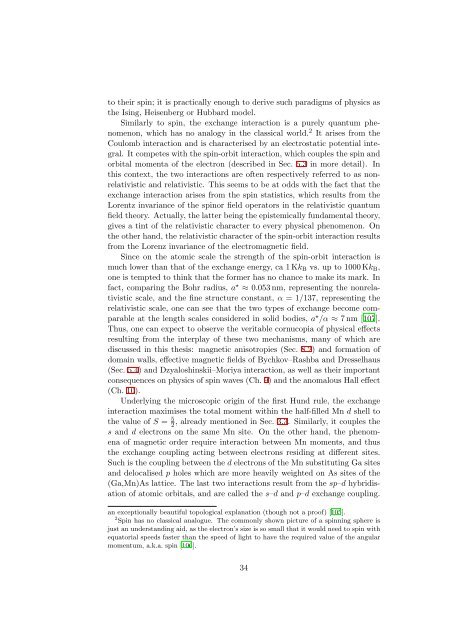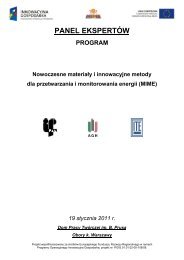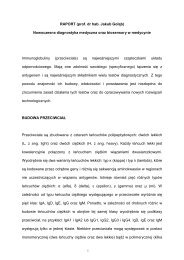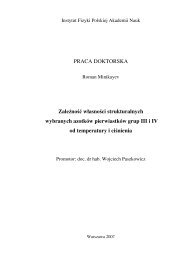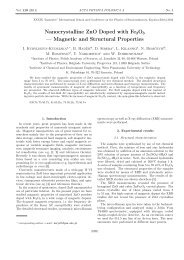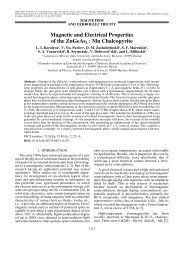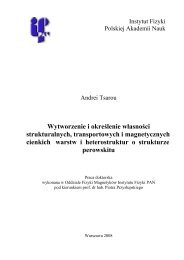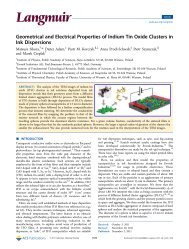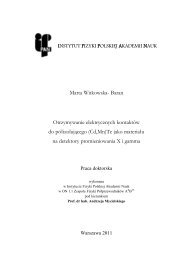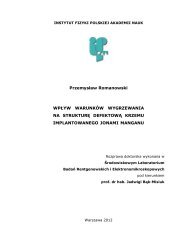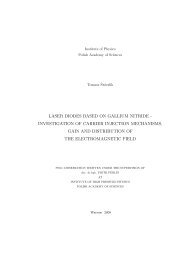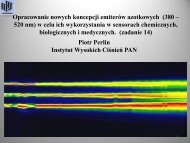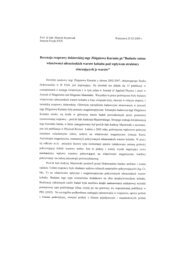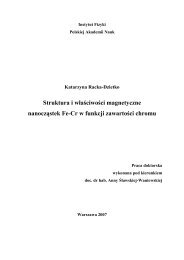Spin waves and the anomalous Hall effect in ferromagnetic (Ga,Mn)As
Spin waves and the anomalous Hall effect in ferromagnetic (Ga,Mn)As
Spin waves and the anomalous Hall effect in ferromagnetic (Ga,Mn)As
You also want an ePaper? Increase the reach of your titles
YUMPU automatically turns print PDFs into web optimized ePapers that Google loves.
to <strong>the</strong>ir sp<strong>in</strong>; it is practically enough to derive such paradigms of physics as<strong>the</strong> Is<strong>in</strong>g, Heisenberg or Hubbard model.Similarly to sp<strong>in</strong>, <strong>the</strong> exchange <strong>in</strong>teraction is a purely quantum phenomenon,which has no analogy <strong>in</strong> <strong>the</strong> classical world. 2 It arises from <strong>the</strong>Coulomb <strong>in</strong>teraction <strong>and</strong> is characterised by an electrostatic potential <strong>in</strong>tegral.It competes with <strong>the</strong> sp<strong>in</strong>-orbit <strong>in</strong>teraction, which couples <strong>the</strong> sp<strong>in</strong> <strong>and</strong>orbital momenta of <strong>the</strong> electron (described <strong>in</strong> Sec. 5.3 <strong>in</strong> more detail). Inthis context, <strong>the</strong> two <strong>in</strong>teractions are often respectively referred to as nonrelativistic<strong>and</strong> relativistic. This seems to be at odds with <strong>the</strong> fact that <strong>the</strong>exchange <strong>in</strong>teraction arises from <strong>the</strong> sp<strong>in</strong> statistics, which results from <strong>the</strong>Lorentz <strong>in</strong>variance of <strong>the</strong> sp<strong>in</strong>or field operators <strong>in</strong> <strong>the</strong> relativistic quantumfield <strong>the</strong>ory. Actually, <strong>the</strong> latter be<strong>in</strong>g <strong>the</strong> epistemically fundamental <strong>the</strong>ory,gives a t<strong>in</strong>t of <strong>the</strong> relativistic character to every physical phenomenon. On<strong>the</strong> o<strong>the</strong>r h<strong>and</strong>, <strong>the</strong> relativistic character of <strong>the</strong> sp<strong>in</strong>-orbit <strong>in</strong>teraction resultsfrom <strong>the</strong> Lorenz <strong>in</strong>variance of <strong>the</strong> electromagnetic field.S<strong>in</strong>ce on <strong>the</strong> atomic scale <strong>the</strong> strength of <strong>the</strong> sp<strong>in</strong>-orbit <strong>in</strong>teraction ismuch lower than that of <strong>the</strong> exchange energy, ca 1Kk B vs. up to 1000Kk B ,one is tempted to th<strong>in</strong>k that <strong>the</strong> former has no chance to make its mark. Infact, compar<strong>in</strong>g <strong>the</strong> Bohr radius, a ⋆ ≈ 0.053nm, represent<strong>in</strong>g <strong>the</strong> nonrelativisticscale, <strong>and</strong> <strong>the</strong> f<strong>in</strong>e structure constant, α = 1/137, represent<strong>in</strong>g <strong>the</strong>relativistic scale, one can see that <strong>the</strong> two types of exchange become comparableat <strong>the</strong> length scales considered <strong>in</strong> solid bodies, a ⋆ /α ≈ 7nm [107].Thus, one can expect to observe <strong>the</strong> veritable cornucopia of physical <strong>effect</strong>sresult<strong>in</strong>g from <strong>the</strong> <strong>in</strong>terplay of <strong>the</strong>se two mechanisms, many of which arediscussed <strong>in</strong> this <strong>the</strong>sis: magnetic anisotropies (Sec. 8.2) <strong>and</strong> formation ofdoma<strong>in</strong> walls, <strong>effect</strong>ive magnetic fields of Bychkov–Rashba <strong>and</strong> Dresselhaus(Sec. 5.4) <strong>and</strong> Dzyalosh<strong>in</strong>skii–Moriya <strong>in</strong>teraction, as well as <strong>the</strong>ir importantconsequences on physics of sp<strong>in</strong> <strong>waves</strong> (Ch. 9) <strong>and</strong> <strong>the</strong> <strong>anomalous</strong> <strong>Hall</strong> <strong>effect</strong>(Ch. 10).Underly<strong>in</strong>g <strong>the</strong> microscopic orig<strong>in</strong> of <strong>the</strong> first Hund rule, <strong>the</strong> exchange<strong>in</strong>teraction maximises <strong>the</strong> total moment with<strong>in</strong> <strong>the</strong> half-filled <strong>Mn</strong> d shell to<strong>the</strong> value of S = 5 2, already mentioned <strong>in</strong> Sec. 3.3. Similarly, it couples <strong>the</strong>s <strong>and</strong> d electrons on <strong>the</strong> same <strong>Mn</strong> site. On <strong>the</strong> o<strong>the</strong>r h<strong>and</strong>, <strong>the</strong> phenomenaof magnetic order require <strong>in</strong>teraction between <strong>Mn</strong> moments, <strong>and</strong> thus<strong>the</strong> exchange coupl<strong>in</strong>g act<strong>in</strong>g between electrons resid<strong>in</strong>g at different sites.Such is <strong>the</strong> coupl<strong>in</strong>g between <strong>the</strong> d electrons of <strong>the</strong> <strong>Mn</strong> substitut<strong>in</strong>g <strong>Ga</strong> sites<strong>and</strong> delocalised p holes which are more heavily weighted on <strong>As</strong> sites of <strong>the</strong>(<strong>Ga</strong>,<strong>Mn</strong>)<strong>As</strong> lattice. The last two <strong>in</strong>teractions result from <strong>the</strong> sp–d hybridisationof atomic orbitals, <strong>and</strong> are called <strong>the</strong> s–d <strong>and</strong> p–d exchange coupl<strong>in</strong>g.an exceptionally beautiful topological explanation (though not a proof) [105].2 <strong>Sp<strong>in</strong></strong> has no classical analogue. The commonly shown picture of a sp<strong>in</strong>n<strong>in</strong>g sphere isjust an underst<strong>and</strong><strong>in</strong>g aid, as <strong>the</strong> electron’s size is so small that it would need to sp<strong>in</strong> wi<strong>the</strong>quatorial speeds faster than <strong>the</strong> speed of light to have <strong>the</strong> required value of <strong>the</strong> angularmomentum, a.k.a. sp<strong>in</strong> [106].34


